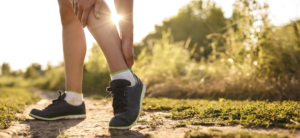Achilles tendonitis

The Achilles Tendon
The Achilles tendon is the largest tendon in the body. It forms from the calf muscles and attaches to the back of the heel bone. It functions to plantarflex the ankle (point the foot down). If the calf muscles are too tight, then excess tension can build up in the tendon or foot. A small bursa is located between the Achilles tendon and bone. It functions to cushion the tendon from rubbing against the heel bone during movement of the ankle.
What is Achilles tendonitis?
Inflammation of the Achilles tendon is called tendonitis. The inflammation can build up on the outside of the tendon, within the tendon, or in the bursa between the tendon and heel bone. Tendonitis occurs from overuse, tight calf muscles, jumping, running uphill, or excessive pronation. Pain and swelling of the tendon are the most common features. Stretching the tendon can cause pain on and many patients will complain their tendon feels tight.
What is Achilles tendinosis?
A problem more serious than tendonitis is a condition called tendinosis. This occurs over a longer period of time than tendonitis but indicates the tendon has become damaged through repetitive strain. In tendinosis, normal tendon tissue is replaced by scar tissue. This weakens the tendon leading to the possibility of a tear or even rupture. Because of the serious nature of tendinosis, examination and treatment from a doctor is important. The distinction between tendonitis and tendinosis is made based on an ultrasound or MRI. Symptoms include the same pain and swelling noted in tendonitis, but the tendon will have a nodule or thickened section.
How are Achilles tendonitis and tendinosis treated?
Most cases of Achilles tendonitis will resolve with conservative care. Healing can take anywhere from a few weeks to 3 months depending on the severity and duration of the symptoms. Typically, conservative treatment focuses on the the inflammation and mechanical tension within the tendon and calf muscles. This is best accomplished by calf stretches, heel lifts, activity modifications, and sometimes shoe changes and orthotics. Physical therapy becomes important when the symptoms have been present for a long duration or when the fail to improve with simple home treatment. Tendinosis typically requires more aggressive immobilization of the tendon and physical therapy. An emerging therapy is the use of stem cell and PRP injections into damaged or diseased portions of the tendon. These injections introduce growth factors to assist the tendon with healing. When the tendon fails to improve with these treatments, surgery is warranted. Typically, 3 months should pass before surgery is considered.
When can I return to running?
The goal of rehabilitation is return you to running as soon as is safely possible. If you return to a full training load too soon, the injury may return or worsen. Everyone recovers from injury at a different rate, so don’t compare your rehabilitation to other runners. Returning to running is determined by how well your tendon responds to treatment rather than a set number of days or weeks. In general, the longer you have had the symptoms, the longer it will take you to recover. Here are some general guidelines for a full return to running. Keep in mind, some runners may not have to completely stop running, but merely reduce their training load (distance, intensity, frequency) during the rehabilitation process.
- You should be able to bend and straighten your ankle without pain.
- Your tendon should not be swollen.
- You should be able to jog in a straight line without limping.
- You should be able to sprint without limping.
- You should be able to perform 45-degree and 90-degree cuts without difficulty.
- You should be able to jump on both legs without pain.
- You should able to jump on the injured foot and ankle without pain.
What can be done to reduce the chances of developing patellar tendonitis?
The most important factor in preventing Achilles tendonitis involves addressing the root causes. So what are the root causes? It is generally accepted that more than half of all running injuries involve errors in training. This could include total mileage, running intensity, increasing the intensity and mileage too quickly, and finally the physical terrain (hills, trails, etc.). Improving areas of biomechanical deficiency also is important. This involves consistent focus on strength and flexibility of the hips and legs.
This information is not intended to diagnose, treat, or prevent any injury or disease. It is intended to serve as an overview of running-related injuries and should not be used as a substitute for sound medical advice from a doctor or therapist.


